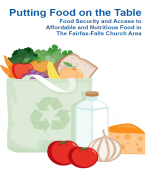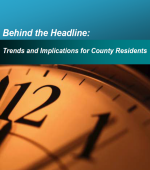Demographics Alert:

Archives - v3
 Published in 1973, and from 1975 to 1991, these reports contain summarized information and trends about Fairfax County, including population characteristics, vital statistics data, educational attainment data, employment data, income data, residential and nonresidential characteristics, housing data, transportation data, county revenues and expenditures data, public safety data, and management indicator data. Please note that the geographies contained in the reports have changed over time.
Published in 1973, and from 1975 to 1991, these reports contain summarized information and trends about Fairfax County, including population characteristics, vital statistics data, educational attainment data, employment data, income data, residential and nonresidential characteristics, housing data, transportation data, county revenues and expenditures data, public safety data, and management indicator data. Please note that the geographies contained in the reports have changed over time.
1991 | 1990 | 1989 | 1988 | 1987 | 1986 | 1985 | 1984 | 1983 | 1982 | 1981 | 1980 | 1979 | 1978 | 1977 | 1976 | 1975 | 1973
 A report and eight brochures profiling immigrant and refugee communities that speak Spanish, Urdu, Farsi, Korean, Vietnamese, Kurdish, and Somali. This report reviews community strengths, financial wellbeing, employment, educational attainment, family structure and living arrangements, ability to speak English, and community attachment.
A report and eight brochures profiling immigrant and refugee communities that speak Spanish, Urdu, Farsi, Korean, Vietnamese, Kurdish, and Somali. This report reviews community strengths, financial wellbeing, employment, educational attainment, family structure and living arrangements, ability to speak English, and community attachment.
By community: Farsi | Korean | Kurdish | Salvadoran | Somali | Spanish | Urdu | Vietnamese
 This survey provides information about population characteristics, educational attainment, employment, health insurance, mental health, long-term care needs, day care, English proficiency, income, and housing. Conducted jointly by Fairfax County, the City of Fairfax, the City of Falls Church, and the Fairfax-Falls Church United Way.
This survey provides information about population characteristics, educational attainment, employment, health insurance, mental health, long-term care needs, day care, English proficiency, income, and housing. Conducted jointly by Fairfax County, the City of Fairfax, the City of Falls Church, and the Fairfax-Falls Church United Way.
By topic: General Overview | Poverty Status | Language Spoken at Home | Children 18 Years and Under | Persons 65 Years and Older | Persons with Disabling Conditions | Health Insurance Coverage
 This report contains tables describing health insurance coverage rates, the characteristics of the uninsured, the availability of private and public coverage, the stability and adequacy of health coverage, and health care utilization.
This report contains tables describing health insurance coverage rates, the characteristics of the uninsured, the availability of private and public coverage, the stability and adequacy of health coverage, and health care utilization.
 A report reviewing, forecasting, and identifying the implications of economic and demographic trends in Fairfax County. This report focuses on how those trends are most likely to impact county government services and community needs. Trends are organized around eleven topic areas.
A report reviewing, forecasting, and identifying the implications of economic and demographic trends in Fairfax County. This report focuses on how those trends are most likely to impact county government services and community needs. Trends are organized around eleven topic areas.


 Fairfax County has experienced increasing economic need over the past decade. The growth in economic need has impacted the county's children and young adults the most. This report explores these trends and discusses some of the factors contributing to the expansion of economic need in Fairfax County.
Fairfax County has experienced increasing economic need over the past decade. The growth in economic need has impacted the county's children and young adults the most. This report explores these trends and discusses some of the factors contributing to the expansion of economic need in Fairfax County.
 Children in families who are vulnerable, sustaining or thriving based on sixteen categories that measure well-being. Shelter costs, overcrowding, income, government assistance, parental employment, number of parents working, citizenship status, education, language, disconnected youth, academic progress, health insurance, disabilities, family structure, community ties, and vehicle access.
Children in families who are vulnerable, sustaining or thriving based on sixteen categories that measure well-being. Shelter costs, overcrowding, income, government assistance, parental employment, number of parents working, citizenship status, education, language, disconnected youth, academic progress, health insurance, disabilities, family structure, community ties, and vehicle access.
